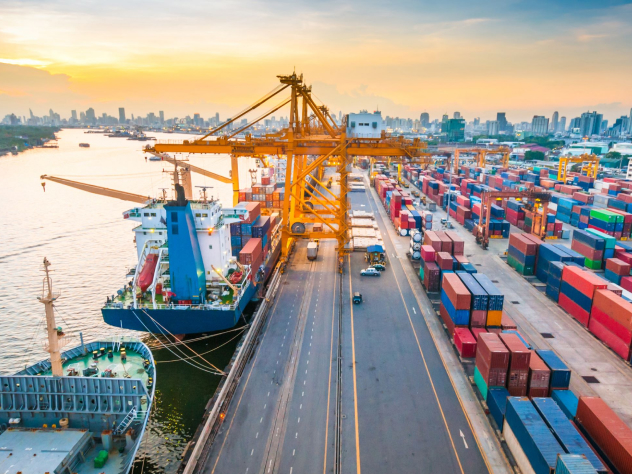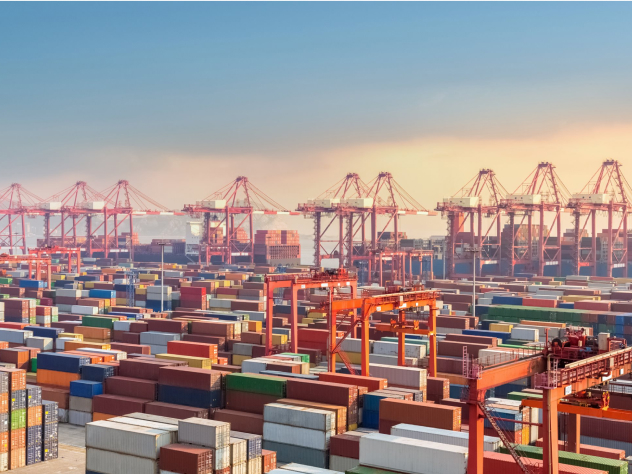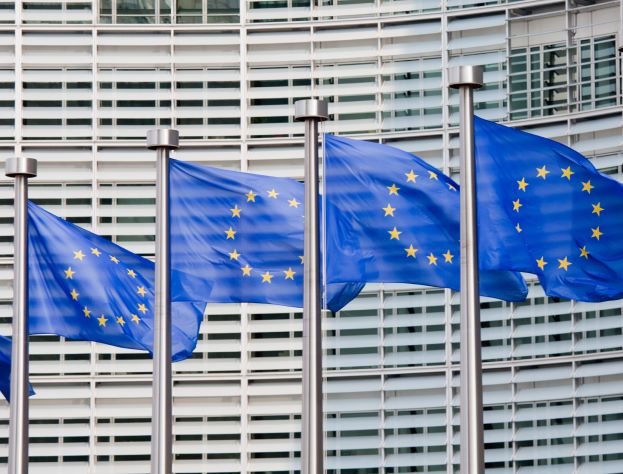Back Live blog: updates on global trade and tariffs
Services
Updates on global trade and tariffs
The news of tariffs continues to unfold and change frequently. This fluid situation may lead to questions from you, our customers. With this blog, we help you to stay up to date on relevant tariff developments and their potential impact.
Updates

 12 June 2025: New tariff agreement between China and the U.S.
12 June 2025: New tariff agreement between China and the U.S.
Following further negotiations, the United States and China have reached a new tariff agreement. Under the deal, the U.S. will impose a total tariff of 55% on Chinese imports, comprising a 10% universal reciprocal tariff, a 20% tariff related to fentanyl trafficking, and a
long-standing 25% tariff on Chinese goods. In response, China will levy a 10% tariff on U.S. imports while maintaining its supply of rare earth minerals—crucial for the automotive industry—to the U.S.

 4 June 2025: U.S. Raises Steel and Aluminum Tariffs to 50%
4 June 2025: U.S. Raises Steel and Aluminum Tariffs to 50%
Last night, the U.S. president signed an executive proclamation that raises the tariffs on imported steel and aluminium from 25% to 50% as of June 4th.
Imports from the United Kingdom will remain at 25% for now, with potential adjustments based on the U.S.-UK Economic Prosperity Deal. The administration is also tightening enforcement by requiring accurate declarations of steel and aluminum content, with penalties for violations.
This move follows findings that global overcapacity and subsidized imports have weakened U.S. production and threaten the country’s ability to meet defense and infrastructure needs.
Learn more here.

 26 May 2025: U.S. postpones tariffs on the EU until July 9
26 May 2025: U.S. postpones tariffs on the EU until July 9
The U.S. President had initially announced a 50% tariff on European Union imports, set to take effect on June 1st. However, following high-level discussions with the President of the European Commission over the weekend, the implementation of these tariffs has been postponed to July 9th. This extension provides both parties with additional time to continue trade negotiations.

 21 May 2025: CBP Tariff FAQs address feeder vessel scenarios and applicability of reciprocal tariffs
21 May 2025: CBP Tariff FAQs address feeder vessel scenarios and applicability of reciprocal tariffs
U.S. Customs and Border Protection (“CBP”) updated its Frequently Asked Questions (“FAQ”) website to include scenarios where IEEPA reciprocal tariffs would or would not apply to in-transit cargo.
Among other valuable answers regarding tariffs, the FAQ listed two scenarios for the trade’s understanding. Listed below are those scenarios:
How are feeder vessel scenarios impacted by the in-transit guidance for reciprocal entries?
Answer–Scenario A: Prior to the cutoff date for the reciprocal tariff in-transit provision, U.S. bound cargo is loaded onto a vessel destined for the U.S. En route to the U.S., this vessel stops at foreign ports to load/offload other cargo, or refuel, but the U.S. bound cargo remains onboard. This vessel arrives at a U.S. port of entry to unload the U.S. bound cargo and make entry.
The cargo in this scenario does qualify for the exception from reciprocal tariffs pursuant to the in-transit provision because prior to the cutoff date, the U.S. bound cargo was laden onto a vessel destined for the U.S. upon departure from the original port of loading and was never unladen or transferred onto another vessel.
Consequently, this vessel constitutes the “final mode of transit” for the laden goods.
Answer– Scenario B: Prior to the cutoff date for the reciprocal tariff in-transit provision, U.S. bound cargo is loaded onto a vessel destined for a foreign port prior to shipment to the U.S. At this foreign port, after the cutoff date, the U.S. bound cargo is transferred onto a different vessel that is destined for the U.S. This new vessel then arrives at a U.S. port of entry to unload the U.S. bound cargo and make entry.
The cargo in this scenario does not qualify for the in-transit exception for reciprocal tariffs because the U.S. bound cargo was laden onto a vessel destined for the U.S. after the cutoff date irrespective of when it departed from the original port of lading; it was thus not loaded onto a vessel that was the final mode of transit prior to the cutoff date for the reciprocal tariff in-transit exception.
The FAQ can be found here.

 12 May 2025: Executive Order reduces elevated duty rates against China origin goods
12 May 2025: Executive Order reduces elevated duty rates against China origin goods
A Presidential Executive Order issued on May 12 temporarily revises reciprocal tariff measures originally implemented under Executive Order 14257 and its amendments.
Temporary Reduction in Ad Valorem Tariffs
Effective May 14, 2025, the U.S. will suspend 24 percentage points of the ad valorem duties on Chinese-origin goods (including Hong Kong and Macau) for 90 days. During this period, covered imports will be subject to a reduced 10% duty rate, down from prior levels as high as 125%. Existing product-specific exclusions and exceptions remain in force.
This change:
- Temporarily suspends the 34% country-specific rate under Executive Order 14257.
- References the April 11, 2025, Presidential Memorandum, which clarified exemptions (e.g., semiconductors).
- Removes tariffs introduced under Executive Order 14259 (84%) and Executive Order 14266 (increased rates to 125% and adjustments on low-value shipments).
De Minimis and Low-Value Import Provisions
The duty on low-value, synthetic opioid-related goods from China is reduced from 120% to 54%.
The $100 flat duty per postal item remains in place and will not increase to $200 as previously scheduled for June 1, 2025.
No mention of retroactive application of these reduced tariffs was made. These reductions will remain in effect for 90 days, unless extended or revised.
A copy of the Executive Order can be found here.

 2 May 2025: Tariff exclusions and non-stacking rule update
2 May 2025: Tariff exclusions and non-stacking rule update
The U.S. Administration has issued an Executive Order eliminating overlapping U.S. tariffs. The new non-stacking rule ensures that if a product falls under multiple tariff actions—including those on steel, aluminum, auto parts, and border-related trade—only one duty applies, based on policy priority.
As indicated in our update from May 1, for importers of automobiles and auto parts, this could mean avoiding additional Section 232 steel and aluminum duties, as well as IEEPA fentanyl tariffs for Canadian or Mexican goods.
The rule applies retroactively to goods entered on or after March 4, 2025, with changes required in the HTSUS by May 16, 2025. Other duties such as Section 301, antidumping, or countervailing duties remain unaffected. CBP and other federal agencies will update systems, issue guidance, and process refunds for overpaid duties. For further details, refer to the Executive Order.

 1 May 2025: End of tariff stacking provides relief for U.S. automakers
1 May 2025: End of tariff stacking provides relief for U.S. automakers
On April 29, President Trump approved new relief for U.S. automakers affected by his 25% Section 232 autos tariffs, aiming to boost domestic production. The change ends tariff ‘stacking’—affected autos and auto parts won’t face additional tariffs that have been imposed on steel, aluminum, and/or Canada/Mexico-related tariffs.
The Trump administration will also offer a temporary credit of 3.75% off the vehicles MSRP, which will allow automakers to offset some parts import costs (excluding Chinese goods) based on the value of vehicles assembled in the U.S., with the credit declining after the first year—ending in 2027. Vehicles assembled in Canada or Mexico don’t qualify.
The move offers short-term relief to U.S. automakers but continues to disrupt North American supply chains and adds complexity for foreign trade partners.

 28 April 2025: Federal Register Notice with details on the end of De Minimis for China and Hong Kong on May 2
28 April 2025: Federal Register Notice with details on the end of De Minimis for China and Hong Kong on May 2
A Federal Register notice has been released with details for the implementation of the U.S. Administration's Executive Order of April 2 to end de minimis for products from China and Hong Kong as of May 2. This notice is set to be published in the federal register later today on April 28.
The end of de minis means that shipments entering the U.S. from China or Hong Kong, which are valued at $800 or less, shall be subject to one of the following duties:
- A duty of 120% of the value of the item
- Or a specific duty of $100 per item (as of June 1, a specific duty rate of $200 per item will apply)

 15 April 2025: CBP guidance on exclusions from reciprocal tariffs for specific products
15 April 2025: CBP guidance on exclusions from reciprocal tariffs for specific products
A CBP guidance was issued identifying certain HTSUS classified products as excluded from reciprocal tariffs. This guidance followed a Presidential Memorandum on April 11, 2025.
The guidance issued under CSMS 64724565 listed multiple headings and subheadings of the Harmonized Tariff Schedule of the United States (HTSUS) that are excluded from the reciprocal tariffs issued under Executive Order 14257:
- 8471
- 8473.30
- 8486
- 8517.13.00
- 8517.62.00
- 8523.51.00
- 8524
- 8528.52.00
- 8541.10.00
- 8541.21.00
- 8541.29.00
- 8541.30.00
- 8541.49.10
- 8541.49.70
- 8541.49.80
- 8541.49.95
- 8541.51.00
- 8541.59.00
- 8541.90.00
- 8542
These headings describe products such as computers and parts, machines that manufacture semiconductor wafers and integrated circuits, smartphones and other electronic communication products, solid state storage devices, flat panel display modules, monitors, and other semiconductor devices. Imported products properly classified under the listed HTSUS provisions are excluded from
the reciprocal tariffs.
The guidance addressed possible refunds on entries made with these HTSUS provisions for products classified under the referenced HTSUS provisions that are entered for consumption or withdrawn from warehouse for consumption on or after April 5, 2025, filers should promptly take corrective action to ensure the applicable exception under heading 9903.01.32 is properly reflected. Such corrections should be made within 10 days of the release of the cargo from CBP custody.
To request a refund, importers may submit a post summary correction (PSC) for unliquidated entries. For entries that have already liquidated but remain within the protest period, a formal protest may be filed, provided the liquidation is not yet final.
The Presidential Memorandum can be found here and the CBP Guidance here.

 14 April 2025: Electronics exempt from U.S. reciprocal tariffs
14 April 2025: Electronics exempt from U.S. reciprocal tariffs
As per revised guidance issued by U.S. Customs and Border Protection on Friday, April 11, electronic imports are now excluded from the U.S. Administration's reciprocal tariffs. This exemption, retroactively effective from April 5, encompasses items such as smartphones, computers, and components like semiconductors and memory cards.

 11 April 2025: China to impose a 125% tariff on U.S. products
11 April 2025: China to impose a 125% tariff on U.S. products
Following a tit-for-tat exchange of tariffs between the US and China, China has imposed a significant retaliatory tariff of 125% on U.S. products. This new tariff will take effect on April 12.

 9 April 2025: U.S. Administration temporarily lowers tariffs for most countries
9 April 2025: U.S. Administration temporarily lowers tariffs for most countries
The U.S. Administration has announced to temporarily lower the new tariffs for nearly all trading partners, excluding China. This announcement came less than 24 hours after the new tariffs would take effect.
According to official statements, new targeted tariffs on other trading partners would be suspended for 90-days to allow time for U.S. officials to negotiate with willing countries; however, the 10% blanket duty on nearly all imports, along with existing tariffs on autos, steel, and aluminium, appear to remain in place. Simultaneously, the U.S. Administration mentioned an increase of the tariff on Chinese imports to 125% from the 104% that came into effect at midnight on April 9.

 9 April 2025: Cumulative tariff of 104% for Chinese goods
9 April 2025: Cumulative tariff of 104% for Chinese goods
The U.S. Administration first introduced a 34% tariff increase on Chinese imports. In response to China's 34% retaliatory tariffs on American goods, an additional 50% duty was imposed. This raised the cumulative tariff to 104%, factoring in the existing 20%. The new tariff officially took effect on April 9.

 7 April 2025: Elimination of duty-free De minimis treatment under Section 321
7 April 2025: Elimination of duty-free De minimis treatment under Section 321
The U.S. President signed an Executive Order eliminating duty-free treatment under 19 U.S.C. 1321(a)(2)(C) for imported products of China and Hong Kong. Section 321 of the U.S. Tariff Act allows for the duty-free importation of goods valued at $800 or less per shipment, provided they are imported by one person on one day and meet all other eligibility requirements.
With the removal of this favorable treatment, imported goods sent through networks other than international postal systems that are valued at or under $800 and that would otherwise qualify for the de minimis exemption will be subject to all applicable duties, including Section 301 (up to 25%) and IEEPA (International Emergency Economic Powers Act) tariffs (20%), and an entry would be required.
Shipments that are sent through the international postal network that are valued at or under $800 and that would otherwise qualify for the de minimis exemption are subject to a duty rate of either 30% of their value or $25 per item (increasing to $50 per item after June 1, 2025).
The Executive Order can be found here.

 4 April 2025: China hits back with tariffs on U.S. imports
4 April 2025: China hits back with tariffs on U.S. imports
China retaliates against the U.S. with a 34% tariff on all American products as of April 10. Also the European Union and Canada announced retaliatory measures.

 3 April 2025: New universal and reciprocal tariffs announced by the U.S. Administration
3 April 2025: New universal and reciprocal tariffs announced by the U.S. Administration
Universal tariff
Using the authority of the International Emergency Economic Powers Act of 1977 (IEEPA), the President signed an Executive Order confirming that on April 5th, 2025, a 10% tariff on all imported products from all countries will be imposed.
These tariffs shall apply to goods entered for consumption, or withdrawn from warehouse for consumption, on or after 12:01 a.m. eastern daylight time on April 5, 2025, except for goods loaded onto a vessel at the port of loading and in transit on the final mode of transit before 12:01 a.m. eastern daylight time on April 5, 2025, and entered for consumption or withdrawn from warehouse for consumption after 12:01 a.m. eastern daylight time on April 5, 2025, shall not be subject to such additional duty.
Tariffs on cars
As announced earlier, a 25% tariff will apply to cars as of April 3rd, 2025. If a car is built in the U.S., there will be no tariff, and parts covered under the United States–Mexico–Canada Agreement (USMCA) trade deal will not be impacted initially.
Reciprocal tariffs
The Executive Order also imposes higher country-specific rates to countries deemed to have excessive tariffs and trade barriers against U.S. products imported into their country.
Although not specified in the Executive Order, at a Rose Garden event on April 2nd the President indicated that the following tariff rates would apply to these countries:
• 49% on Cambodian goods
• 48% on Laotian goods
• 47% on goods from Madagascar
• 46% on Vietnamese goods
• 44% on Sri Lankan goods
• 44% on goods from Myanmar
• 37% on Serbian goods
• 37% on goods from Botswana
• 37% on Bangladeshi goods
• 36% on Thai goods
• 34% on Chinese goods
• 32% on Taiwanese goods
• 32% on Indonesian goods
• 31% on Swiss goods
• 30% on South African goods
• 29% on Pakistani goods
• 28% on Tunisian goods
• 27% on Kazakh goods
• 26% on Indian goods
• 25% on South Korean goods
• 24% on Malaysian goods
• 24% on Japanese goods
• 21% on goods from Cote D'Ivoire
• 20% on Jordanian goods
• 20% on EU goods
• 18% on Nicaraguan goods
• 17% on Israeli goods
• 17% on Filipino goods
• 15% on Norwegian goods
Those duties will apply to goods entered for consumption, or withdrawn from warehouse for consumption, on or after 12:01 a.m. eastern daylight time on April 9, 2025, except for goods loaded onto a vessel at the port of loading and in transit on the final mode of transit before 12:01 a.m. eastern daylight time on April 9, 2025, and entered for consumption or withdrawn from warehouse for consumption after 12:01 a.m. eastern daylight time on April 9, 2025, shall not be subject to these country-specific ad valorem rates of duty set forth in Annex I to the Order.
Additional details and countries will be updated after the publication of the Executive Order. Expect U.S. Customs and Border Protection (“CBP”) to also issue guidance on how the entries should be filed.

 27 March 2025: U.S. President Trump to impose 25% tariff on imported cars
27 March 2025: U.S. President Trump to impose 25% tariff on imported cars
U.S. President Trump announced a 25% tariff on all automotive imports, effective April 2, the same date he plans to announce reciprocal tariffs. If a car is built in the U.S., there will be no tariff, and parts covered under the United States–Mexico–Canada Agreement (USMCA) trade deal will not be impacted initially.

 13 March 2025: Canadian tariffs on $29.8 billion in products from U.S. take effect
13 March 2025: Canadian tariffs on $29.8 billion in products from U.S. take effect
Canada is imposing a 25% tariff on $29.8 billion in products imported from the United States (U.S.). These tariffs only apply to goods originating from the U.S., which shall be considered in accordance with the Determination of Country of Origin for the Purpose of Marking Goods (CUSMA Countries) Regulations.
The Canadian government has stated that these countermeasures will remain in place until the U.S. eliminates its tariffs against Canadian steel and aluminum products. Canada’s countermeasures do not apply to U.S. goods that are in transit to Canada on the day on which they come into force. Additional details on the administration of these tariffs are available on the Canada Border Services Agency website: Customs Notices (cbsa-asfc.gc.ca).
To see the full list of affected U.S. goods, click here. This list outlined at the tariff item level in the table should be read in conjunction with the Schedule to Canada’s Customs Tariff.

 12 March 2025: U.S. tariffs on all steel and aluminum imports take effect
12 March 2025: U.S. tariffs on all steel and aluminum imports take effect
Today, a 25% tariff on aluminum and steel imports to the U.S. from all countries has taken effect. The EU has announced retaliatory measures set to take effect in April.

 7 March 2025: U.S. delays tariffs on a range of goods from Canada and Mexico for one month
7 March 2025: U.S. delays tariffs on a range of goods from Canada and Mexico for one month
On Wednesday, the U.S. exempted automotive goods from the 25% tariffs that had been imposed on imports from Canada and Mexico as of Tuesday.
Now, the U.S. also announced a one-month suspension of the 25% tariffs on all goods compliant with the United States-Mexico-Canada Agreement (USMCA). Kuehne+Nagel is closely monitoring all details, including the impact on duties already paid since March 4, 2025, on goods that are now exempted.
According to the latest reports, a 25% tariff on imports of steel and aluminum will still take effect as scheduled on March 12, 2025.

 4 March 2025: imports from Canada and Mexico are now to be taxed at 25%
4 March 2025: imports from Canada and Mexico are now to be taxed at 25%
A 25% tariff on Canadian and Mexican imports into the U.S. went into effect after midnight on March 4th, except for Canadian energy products, which are subject to a 10% tariff. Additionally, a 10% tariff on Chinese imports into the U.S. was implemented, applying on top of existing tariffs (meaning a total of 20% tariffs now apply).
In response, China has imposed tariffs on various food and agricultural products from the U.S. The Canadian prime minister has stated that they will immediately apply a 25% tariff on a wide range of U.S. products, and that these tariffs will be expanded if the U.S. tariffs against Canada remain in place after 21 days.

 28 February 2025: Media reports new tariffs for Mexico, Canada, and China starting March 4
28 February 2025: Media reports new tariffs for Mexico, Canada, and China starting March 4
Media reports state that a 25% U.S. tariff on imports from Mexico and Canada will go into effect on March 4th, contrary to earlier reports suggesting a potential delay until April 2nd.
Furthermore, the U.S. president has announced an additional 10% tariff on all goods from China, which are to be applied on the same date, March 4th, on top of the existing 10% tariff which came into effect earlier this month.

 12 February 2025: New U.S. tariffs on steel and aluminium
12 February 2025: New U.S. tariffs on steel and aluminium
The U.S. government announced a 25% tariff on all steel and aluminium imports with March 12, 2025, as the official implementation date. This primarily affects major suppliers from Canada, Mexico, and Brazil.
Companies are encouraged to evaluate any possible effects this tariff may have on their business. Our trade compliance team remains available for inquiries.

 7 February 2025: New 10% tariff from U.S. on de minimis goods
7 February 2025: New 10% tariff from U.S. on de minimis goods
A new U.S. executive order delays the cancellation of the de minimis exemption. This order announced a process to allow de minimis entries through Customs with a 10% tariff on those movements. This program will impact the express consignment carriers but will have no impact on Kuehne+Nagel services.

 4 February 2025: Counter-tariffs from China to U.S. on energy and machinery goods
4 February 2025: Counter-tariffs from China to U.S. on energy and machinery goods
China announced targeted tariffs on specific U.S. imports starting February 10, 2025. These include an extra 15% tariff on U.S. imports of anthracite, coal, coke, lignite and liquified natural gas. This action also poses an additional 10% tariff on U.S. imports of crude oil, various types of agricultural machinery, tractors, large-displacement vehicles and pickup trucks, electric wagons, agricultural trailers and semi-trailers.
This action is a response to the unilateral tariff measures imposed by the United States on Chinese imports.

 3 February 2025: Agreement to pause tariffs between U.S. and Canada / Mexico
3 February 2025: Agreement to pause tariffs between U.S. and Canada / Mexico
Both Mexico and Canada came to an agreement with the U.S. to suspend the 25% tariffs from the U.S. on each country beginning on Tuesday, February 4, 2025. Canada also paused its retaliatory measures.
This pause is to last for at least 30 days.

 3 February 2025: Canada announces 25% counter-tariff on U.S. goods
3 February 2025: Canada announces 25% counter-tariff on U.S. goods
Canada announced retaliatory measures with a 25% tariff on a series of U.S. imports. Please find a list of goods issued from the Canadian government here.

 1 February 2025: New U.S. tariffs on goods from China, Canada and Mexico
1 February 2025: New U.S. tariffs on goods from China, Canada and Mexico
On February 1, 2025, the U.S. president signed executive orders imposing 10% tariffs on all goods from China and 25% tariffs on all goods from Mexico and Canada (except for Canadian energy and oil, for which 10% tariffs will apply). The tariffs are added on top of existing ones and are to take effect on Tuesday, February 4.
Goods in transit before 12:01 a.m. EST on February 1, 2025, may be exempt from these tariffs, provided the importer submits a certification (details to be outlined in a U.S. Federal Register notice).
In addition, the de minimis exemption for goods valued under $800 from China has been revoked. This means that those shipments to the U.S., such as orders from e-commerce customers, will be subject to duties and must follow the same customs clearance processes as other goods entering the country.
DISCLAIMER - All information is provided in good faith for guidance and reference purposes only. It is of a general informational nature, and Kuehne+Nagel takes no legal responsibility for the accuracy of the information provided via this document. Kuehne+Nagel makes no representation as to the accuracy or completeness of any of the information contained herein and accepts no liability for any loss arising from the use of the information provided.












